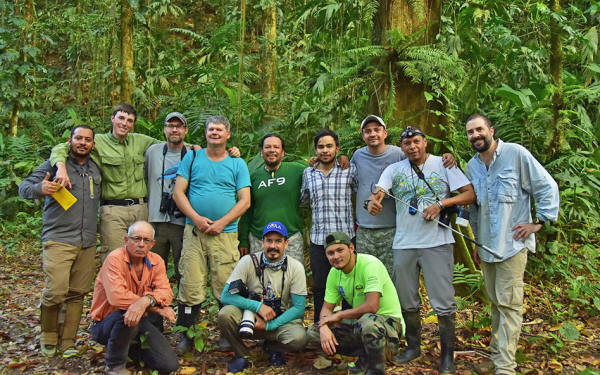|

by Elias Marat
June 24,
2019
from
TheMindUnleashed Website

Scientists found 198 species of birds,
40 of small
mammals,
56 amphibian and
reptile species,
30 of large
mammals,
94 butterfly
species,
and so much
more...
A specialized team of conservation scientists has found what appears
to be a hidden oasis deep in the rainforest of Honduras that's
teeming with dozens of rare and endangered creatures.
The remote settlement, known as the "Lost City of the Monkey God" or
"White City" and located in the
Mosquitia rainforest in Honduras,
is a stunning example of the biodiversity that was once common
across the tropics and rainforests in the region.
The rainforest is home to
hundreds of species of bats, butterflies and reptiles, The
Independent
reports.
The "ecological SWAT team" from Conservation International's
Rapid Assessment Program (RAP)
conducted their three-week expedition in 2017 after ancient ruins
were discovered in the rainforest, which remains one of the
least-explored areas of the region.

The RAP team at the Ciudad del Jaguar base camp.
Left to right; (top) Onan Reyes, Travis King, John van Dort,
Eric van den Berghe, Arnulfo Medina-Fitoria, Manfredo Turcios-Casco,
Olvin Oyuela, Milton Salazar-Saavedra, Trond Larsen;
(bottom) John Polisar, Carlos Funes, Josué Ramos.
Source
Their full report (A
Rapid Biological Assessment of Ciudad del Jaguar, Ciudad Blanca - La
Mosquitia, Honduras) on the
expedition and its dizzying array of findings was only
published this week.
The report details how the pristine ecosystem is filled with a
number of rare and unique species, including those previously
believed to be extinct.
This has included,
22
species were also recorded whose presence in Honduras had previously
been unknown, including,
https://twitter.com/ConservationOrg/status/1142160317805473792
In total, scientists documented,
-
198 species of birds
-
94 butterfly
species
-
40 of small mammals
-
56 amphibian and reptile species
-
30 species of large mammals - including jaguars, ocelots and pumas,
...not to mention a huge variety of plants, fish, rodents and insects.
Trond Larsen, the director of RAP, expressed that his team
was "shocked" by their major find.
In a
press release,
Larsen noted:
"The 'White City' is
one of the few areas remaining in Central America where
ecological and evolutionary processes remain intact."
The conservationist added
that the diversity of the area's wildlife makes it a very high
priority for future conservation efforts.
Larsen said:
"One of the main
reasons we found such high species richness and abundance of
threatened and wide-ranging species (e.g., peccaries) is that
the forests around the White City remain pristine, unlike much
of the region.
This makes the area a high conservation priority for maintaining
the broader landscape connectivity that is essential for the
long-term persistence of biodiversity through Central America."
The White City has long
been sought after by explorers searching for what is believed to be
the home to an ancient civilization that inhabited the area during
the
pre-Columbian era.
The area, which is largely undeveloped, has faced threats from
illegal economic activities such as deforestation due to cattle
ranching, in spite of efforts by Honduras' president in 2005 to
extend official protection to the "lost city."
Larsen said:
"And these are areas
with no road networks, no logistics or infrastructure to let
people get in or let guards in, so it's very hard to stop what's
happening.
In many cases, this illegal activity is being driven
tangentially by drug trafficking, so it's driven by powerful
people with money. That's the primary threat to the integrity of
the forest of the area."
Another member of the RAP
SWAT team, John Polisar, noted the importance of ensuring strong
protection that would allow the treasure-trove of rare creatures to
thrive:
"We have been doing
field work in the indigenous territories of La Moskitia for 14
years, and this site stood out as being simply gorgeous.
Because of its presently intact forests and fauna the area is of
exceptionally high conservation value. It merits energetic and
vigilant protection so its beauty and wildlife persist into the
future."
| 


